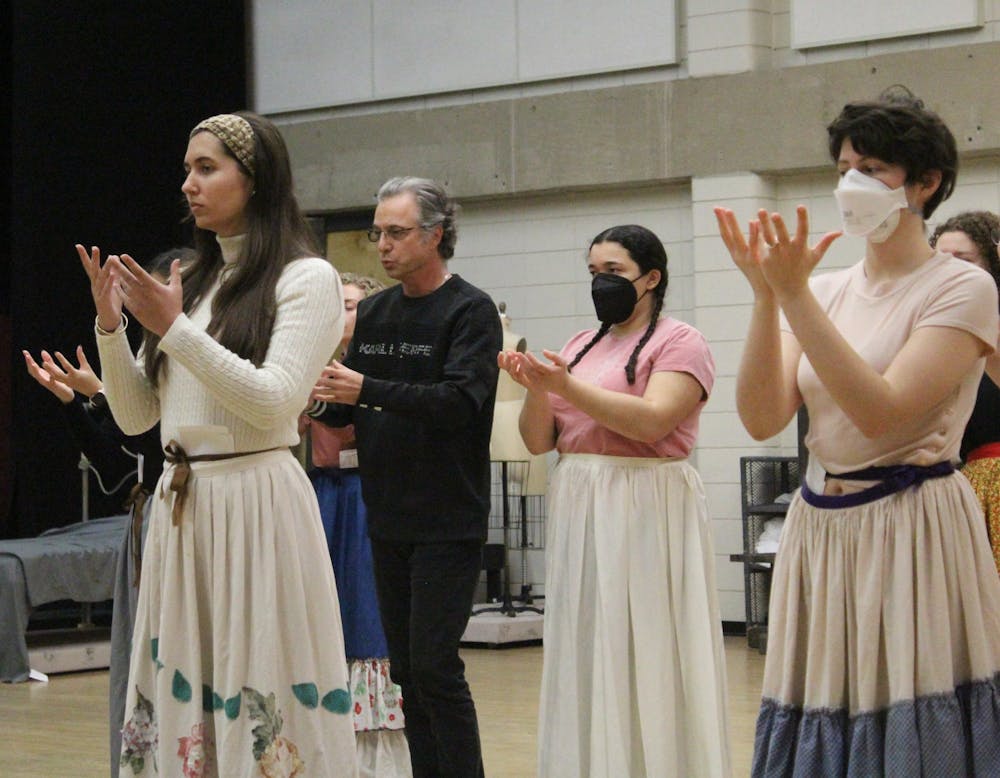The Musical Arts Center will open its first opera of the semester with Osvaldo Golijov’s “Ainadamar,” a story based on the life of Spanish playwright Federico Garcia Lorca. The production is directed by the acclaimed Jeffrey Buchman and choreographed by the talented Rosa Mercedes.
Performances will be held at 7:30 p.m. Feb. 3-4 and Feb. 10-11. Tickets are available through the Jacobs School of Music website.
Buchman is collaborating with his wife Mercedes once again to deliver a unique blend of choreography and storytelling to the stage at the Musical Arts Center. After first working with the Jacobs School of Music on “La Traviata” in 2014, the duo has continued to collaborate on other productions since. The Indiana Daily Student spoke with Buchman and Mercedes about their work on “Ainadamar” on Jan. 19.
IDS: You both come from a performance background. How has that impacted your style of direction and choreography?
Buchman: We both came into this world as performers first. I always come at directing from the outside. I understand what is important and what performers need to do. I often try and push them beyond where they believe they may be able to go because I believe in their potential, perhaps even larger than they believe in it yet. We’re in an art form where the voice really is everything in communicating the drama and what’s going on.
Related: [IU Cinema to show ‘X-Files,’ ‘Mulholland Drive,' and more January and February]
Mercedes: As a choreographer, being a professional dancer and performing for so many is crucial. For me it’s crucial that you perform before so you can apply that when you choreograph. Deeply understanding how singers and the craft of opera are done from the beginning — as a dancer — definitely helped me to understand that art form. For me it was crucial to be able to perform in opera, to understand everything I learned as a dancer to the opera and to be able to do all these styles. Everything tells a story and is so different.
IDS: You two have collaborated on several productions in the past. How do you begin to merge direction and choreography so seamlessly?
Buchman: We have the wonderful gift of being creative with each other all the time and so our creative discussions never stop. We may be out, totally disconnected from work, but we’re discussing inspirations, visions and ideas. I can integrate us in a much deeper way, and I think that comes across in “Ainadamar.” The world of the chorus women and the world of the dancer women is so blended and so integrated that at times you may not know which is which. Then the dancers emerge, kind of blossoming out of what they were doing together with the chorus girls who are also moving quite a bit, and it’s really a wonderful collaborative process.
Mercedes: It should be a collaboration. I believe that in opera, directors and choreographers should be collaborating. Not only on a dance scene but everything, everything is movement and definitely one inspires the other with creative ideas.
IDS: What is it like directing and choreographing a piece that so intricately blends dance and movement in its score?
Buchman: What Golijov has done so beautifully is create an amalgam of sound that is its own vocabulary. You can both feel the underlying Flamenco rhythms while on top of that he’s created a whole different texture that’s playing out on top of those Flamenco rhythms. That’s what makes the piece so wonderfully unique. It’s not that the piece is a Flamenco opera, it’s its own operatic language.
Mercedes: With the score, he (Golijov) beautifully incorporated the Flamenco rhythms to reflect everything about Lorca. Lorca was a lover of Flamenco, so he incorporated bulerias, tangos, even martinete, all these rhythms that mark the score add to the flavor. He made Ruiz Alonso — the man responsible for the death of Lorca — a Flamenco singer. Flamenco singers are very intense, dramatic and raw, and I think it's an incredible idea.
IDS: The story is told through a series of flashbacks as well as in reverse. What was that like from a directing standpoint?
Related: [University Players talk student theater, upcoming production of ‘Sweeney Todd’]
Buchman: It’s nonlinear storytelling. It’s constant departures from a specific point in time. What is this specific point in time? It’s the day that Margarita Xirgu is going to die., it’s that performance that she’s at and never makes it out for that final entrance. Everything from there is a departure point, sometimes we’re departing to memories of meeting Lorca, sometimes we’re departing to her own vision of what it must have been like for Lorca to be murdered. It’s quite beautiful to direct this show because it gives you such poetic freedom in how to tell the story. As a storyteller it’s incredibly rewarding to be given that gift of such an open poetic field.
IDS: The opera is about an artist speaking out against oppression. What’s the relevance in today’s world?
Buchman: There were a lot of issues that can be explored as to why Lorca was a target. I think the importance in the world of the story we’re telling is that Lorca is universal in the world of oppression and the targeting and suppressing of freedoms, justice and law. There is still incredible injustice, there is still an incredible lack of liberty and freedom, and there’s an incredible lack of law and justice. The real message of this piece is legacy. Lorca became a person who fought back against injustice and now hopefully in this world of legacy — we who produce the piece, we who perform the piece, we who are audience members experiencing Ainadamar — we become the next players in this story of fighting for those who don’t have a voice to speak for themselves.




